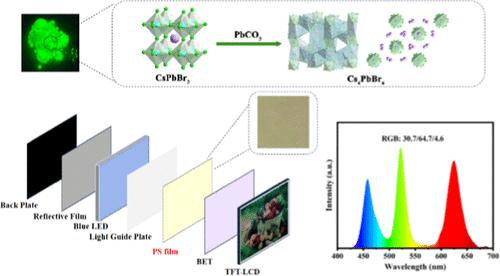成分调节使CsPbBr3/Cs4PbBr6玻璃纳米复合材料用于色彩丰富的背光显示器
IF 8.2
2区 材料科学
Q1 MATERIALS SCIENCE, MULTIDISCIPLINARY
引用次数: 0
摘要
在这项工作中,将碳酸铅(PbCO3)掺入锂铝硅酸盐硼(Li-Al-Si-B)玻璃基体中,合成了CsPbBr3/Cs4PbBr6@glass复合材料。PbCO3分解为PbO, PbO与熔体Br原位反应生成PbBr2,在富Br微畴中触发CsPbBr3/Cs4PbBr6成核;二氧化碳释放同时产生应力释放微孔,优于直接添加PbBr2。该复合材料具有显著的光致发光性能,光致发光量子产率(PLQY)高达86.71%。在120 h的加速老化实验中,荧光强度保持在原始值的95%。即使在水中浸泡60天后,其发光强度仍保持在初始强度的94%,表明其具有出色的抗环境降解能力。为了进一步探索其显示应用的潜力,我们制备了CsPbBr3/Cs4PbBr6/CsPbBrI2@glass@聚苯乙烯(PS)薄膜。该影片展示了令人印象深刻的色域,覆盖了美国国家电视系统委员会(NTSC) 1953年标准的123%和ITU-R建议BT.2020 (Rec.2020)标准的91.3%。CsPbBr3/Cs4PbBr6@glass的高PLQY和优异的稳定性使其非常适合LCD应用,具有工业规模生产的广阔前景。本文章由计算机程序翻译,如有差异,请以英文原文为准。

Composition Regulation Enables Stable CsPbBr3/Cs4PbBr6 Glass Nanocomposites for Color-Rich Backlight Displays
In this work, CsPbBr3/Cs4PbBr6@glass composites were synthesized by incorporating lead carbonate (PbCO3) into a lithium–aluminum–silicate–boron (Li–Al–Si–B) glass matrix. PbCO3 decomposes to PbO, which reacts in situ with melt Br to form PbBr2, triggering CsPbBr3/Cs4PbBr6 nucleation in Br-rich microdomains; CO2 release concurrently creates stress-relieving micropores, outperforming direct PbBr2 addition. This composite exhibited remarkable photoluminescence properties, with a photoluminescence quantum yield (PLQY) reaching as high as 86.71%. In an accelerated aging experiment conducted over 120 h, the fluorescence intensity was maintained at 95% of its original value. Even after 60 days of immersion in water, the luminescence intensity remained at 94% of the initial intensity, demonstrating its outstanding resistance to environmental degradation. To further explore its potential for display applications, we prepared a CsPbBr3/Cs4PbBr6/CsPbBrI2@glass@polystyrene (PS) film. This film exhibited an impressive color gamut, covering 123% of the National Television System Committee (NTSC) 1953 standard and 91.3% of the ITU-R Recommendation BT.2020 (Rec.2020) standard. The high PLQY and excellent stability of CsPbBr3/Cs4PbBr6@glass make it highly suitable for LCD applications and offer broad prospects for industrial-scale production.
求助全文
通过发布文献求助,成功后即可免费获取论文全文。
去求助
来源期刊

ACS Applied Materials & Interfaces
工程技术-材料科学:综合
CiteScore
16.00
自引率
6.30%
发文量
4978
审稿时长
1.8 months
期刊介绍:
ACS Applied Materials & Interfaces is a leading interdisciplinary journal that brings together chemists, engineers, physicists, and biologists to explore the development and utilization of newly-discovered materials and interfacial processes for specific applications. Our journal has experienced remarkable growth since its establishment in 2009, both in terms of the number of articles published and the impact of the research showcased. We are proud to foster a truly global community, with the majority of published articles originating from outside the United States, reflecting the rapid growth of applied research worldwide.
 求助内容:
求助内容: 应助结果提醒方式:
应助结果提醒方式:


